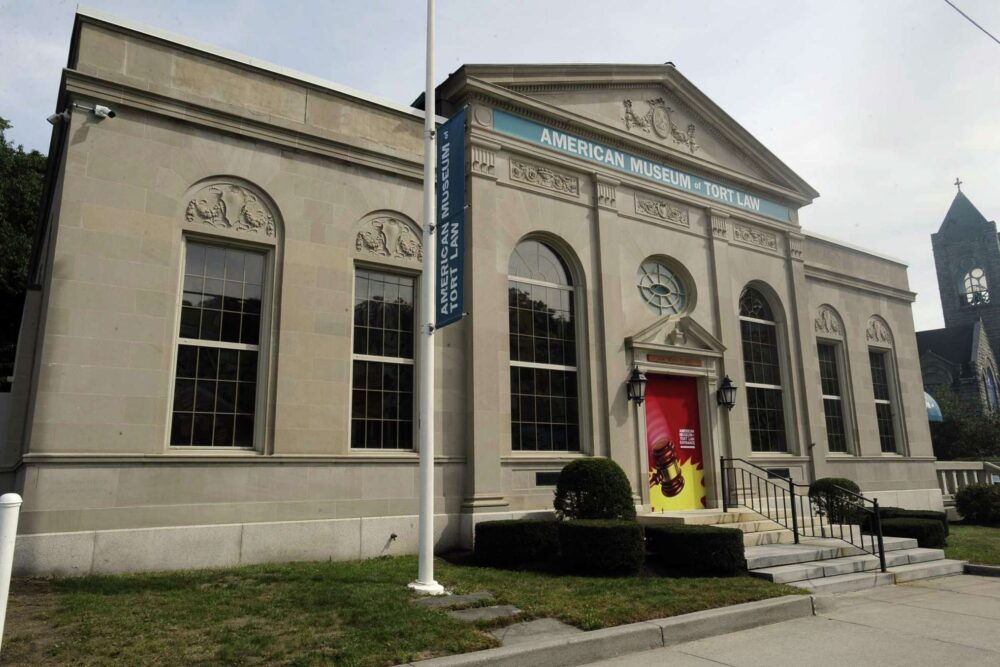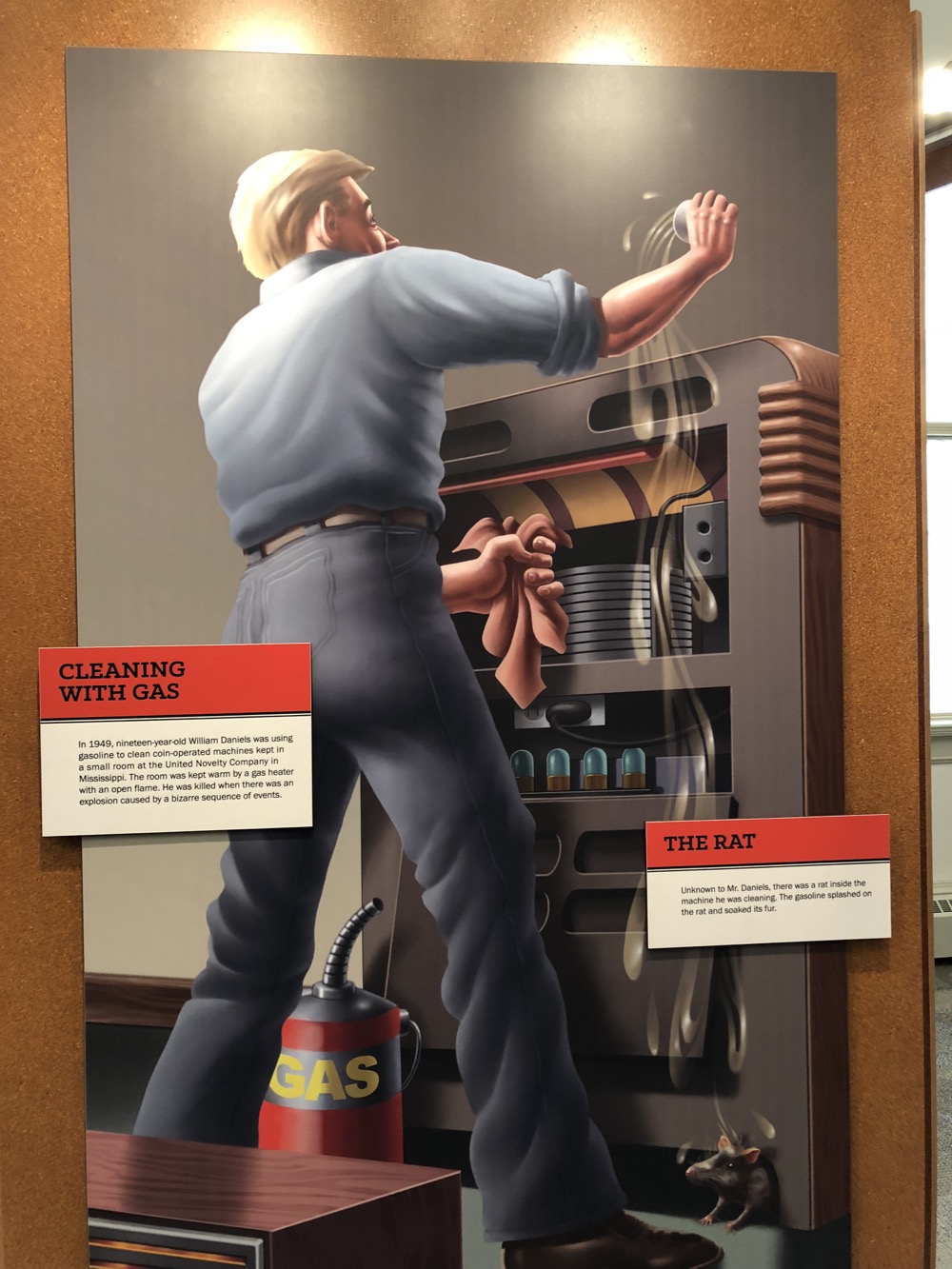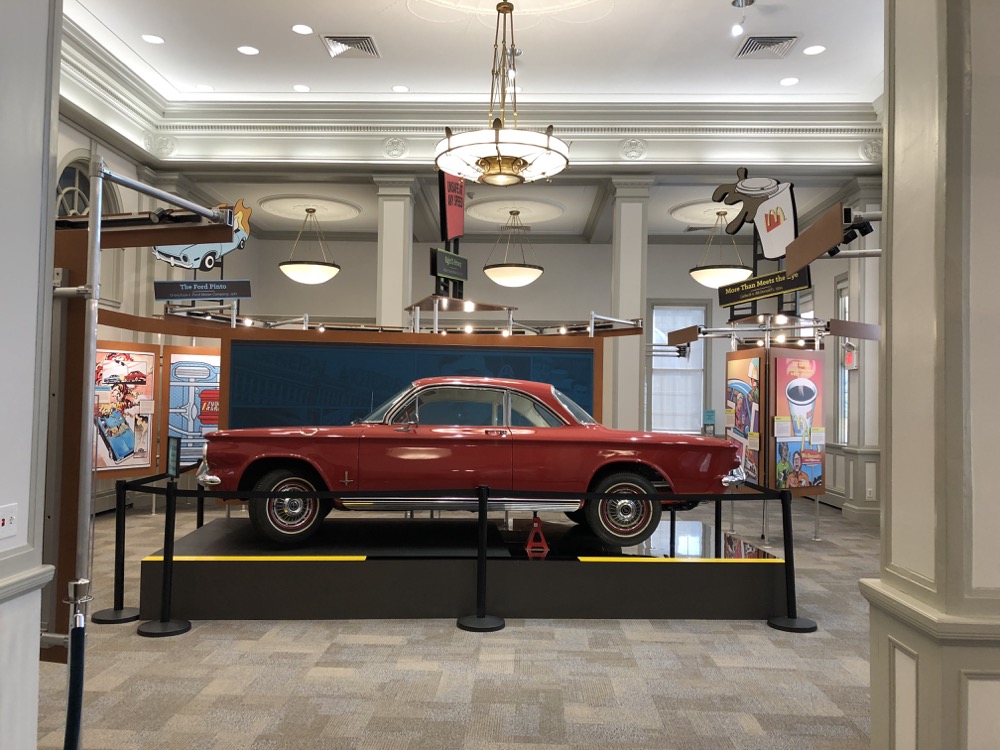The Nadir of Connecticut Museums?
Winchester (Google Maps location)
October 2018
Out of the surfeit of Connecticut museums, you can count on one hand how many have been featured in The New York Times, The Washington Post, The New Yorker, The PBS NewsHour, The Wall Street Journal, and most importantly, CTMQ.

In fact, you can count the number of museums on that list on one hand of a poor soul who had a cherry bomb explode in it, leaving him with only one finger, causing a lawyer to sue the cherry bomb manufacturer citing its responsibility for the maiming injury.
Welcome to Ralph Nader’s American Museum of Tort Law in downtown Winsted, Connecticut!

The mission of the nationally acclaimed American Museum of Tort Law is to educate, inform and inspire Americans about two things: Trial by jury; and the benefits of tort law. For real. That’s the mission. Truly inspiring!
For those of you who don’t know, tort law is the law of wrongful injuries, including motor vehicle crashes, defective products, medical malpractice, and environmental disasters, among many others. And trial by jury is a bedrock American right, guaranteed in our Bill of Rights.


Visitors to the Museum will enjoy learning about tort law and trial by jury, and see how both have improved the lives, not only of those injured, but all of us. The Museum has one gallery of important precedent-setting cases; another gallery exhibiting dangerous toys; and a third with interactive panels, which let visitors learn about seven cases in detail. In addition, our theater runs a brief (11 minute) movie which traces the evolution (and importance) of trial by jury and tort law. The main gallery features cases which made a difference not only to the injured victims, but to everyone: Cases like the Ford Pinto, Liebeck v. McDonalds, and the tobacco and asbestos litigation, among others.
When this place was first announced as an actual thing, The Wall Street Journal began a sort of quiet campaign to make fun of it as much as possible. Ralph Nader conceived of the museum in 1998 and spent the next seventeen years raising $3 million for it – though his early plans expected $5 million in one year. The museum is in a former bank in Winsted; a town not exactly known to be a weekend destination. A quick Google search shows me the WSJ published at least five articles about the museum during its run-up, including a feature when it opened sarcastically titled, “At Last, a Museum on Tort Law.”


Founder Nader probably took those shots as a badge of honor, considering who owns the Journal and all. Nader is one of Connecticut’s most famous residents I’d say, and he chooses to live in Winsted, just as he has his entire life. He’s an American political activist, author, lecturer, and attorney noted for his involvement in consumer protection, environmentalism, and government reform causes.
After graduating from Princeton and Harvard Law School, he first came to prominence in 1965 with the publication of the bestselling book Unsafe at Any Speed, a highly influential critique of the safety record of American automobile manufacturers. He led an investigation of the Federal Trade Commission, leading directly to that agency’s overhaul and reform. In the 1970s, Nader leveraged his growing popularity to establish a number of advocacy and watchdog groups including the Public Interest Research Group, the Center for Auto Safety, and Public Citizen. Two of Nader’s most notable targets were the Chevy Corvair and the Ford Pinto.

Sort of symbolic : (
And of course Nader made four bids to become President of the United States, running with the Green Party in 1996 and 2000, the Reform Party in 2004, and as an independent in 2008. While Al Gore should have beaten George W. Bush regardless, Nader’s stubborn refusal to bow out of the 2000 race certainly played a role in Gore’s defeat. Nader has led quite a full life, and he’s apparently capping it off with a rather polished museum about his favorite thing in the world: Tort Law.
Specifically of the American variety.
There’s really no point getting into the specifics here; just think of it as “stuff that did or could injure people and how that’s a bad thing. For example, the American Museum of Tort Law includes big exhibits on the cases against Big Tobacco, lawn darts, and Liebeck v. McDonald’s – the burning coffee lady case. The three purposes of the law of tort law are the compensation of the wrongfully injured person by the perpetrator, disclosing defects that help educate and alert people, and also deterrence. It deters unsafe practices around the country.

Nader’s life’s work is centered around this, and he’s a true believer in the power of tort law and trials by jury. Take the Corvair and Pinto cases. Sure, the Corvair was designed in such a way that the steering column became a murderous spear anytime the car hit something head-on, and sure, the Pinto blew up when rear-ended, but it took Nader’s cases for President Lyndon Johnson to sign the Motor Vehicle and Highway Safety Laws regulating the auto industry, mandating safety standards like better brakes, better tires, seatbelts, eventually airbags, padded dash panels — all the things we now take for granted.
In fact, it changed standards for automobile manufacturing around the world. Nader credits civil lawsuits for stopping the sale of toys with parts that were choking hazards….and banning asbestos.

The museum, of course, highlights the high profile and successful cases. What about the thousands and thousands of unsuccessful cases? Has tort reform turned us into a much more litigious society? Nader claims that’s not the case at all. There’s a sign here that says that we file fewer civil suits per capita today than we did in the 1840s. I’m not going to chase down the sourcing on that, but… really? (Actually, this is repeated in the video below, and I trust that source. Because Adam ruins everything.)
Though really, who knows. What I do know is that this museum opened in 2015 and has been rumored to be closing more than a few times since. In 2022-23, it is closed for the winter and there are Groupons for you to save a few bucks on your visit. These are not good omens for the continuance of the American Museum of Tort Law. It’s larger than you assume it is, but it’s not that large at 6,000 square feet. And it doesn’t change. If you visit it once, you’re done with it for the rest of your life.

And it’s in Winsted… and, if you weren’t aware, it’s a museum dedicated to Tort Law. And nothing but. (Nader used to say he wanted to expand it far, far beyond what it is and have a whole courtroom in there to host acted-out trials of famous cases for people to watch online and stuff. Sure it took him 17 years to get 3/5 of the money he wanted, but the man is an optimist I guess.)
I enjoyed my visit just the same. The exhibits are well-presented and they’ve chosen some cool cases to highlight. Take the Flaming Rat case:
In nineteen-forties Mississippi, William Daniels, an employee of the United Novelty Company, was cleaning a piece of his employer’s machinery. Daniels was using gasoline as a cleaning agent even though the company had repeatedly told its employees not to clean with gasoline. As he cleaned, the gasoline leaked through the machine and soaked a rat hiding underneath it. The rat ran under another machine for cover—a gas heater. The gas heater’s open flame lit the rat’s gasoline-soaked coat on fire, sending the flaming rat scrambling back toward the machine that Daniels was cleaning. Another drop of gasoline may have fallen on the rat. The resulting explosion killed them both. Daniels was nineteen.


Daniels’s estate sued the United Novelty Company for wrongful death. In 1949, the Supreme Court of Mississippi upheld a jury’s finding that the company was liable for his death. The court suggested that the company’s repeated warnings against cleaning with gasoline proved that the company knew that its employees were using gasoline to clean its machinery and that it was dangerous. The company hadn’t presented any evidence that Daniels himself had heard the warnings against using gasoline, but this was beside the point—it was the company’s responsibility, not the nineteen-year-old’s, to make sure its employees were not blown up while they worked.
Rad. One of the things I keep reading in old articles is that Nader couldn’t believe that there were no museums dedicated to the law before his. He’d cite the vast number of museums in the country and call out the fact that there are museums for all sorts of dumb things, but not the law. The New Yorker article says, “The Museum of American Tort Law itself lies in a prodigious tract of museums. Northwest Connecticut is home to, among many others, the Lock Museum of America, the American Clock & Watch Museum, the New England Carousel Museum, and the Vintage Radio & Communications Museum of Connecticut. The state has four different railroad museums, not including its trolley museums.”


Hey, New Yorker writer, there was a Kerosene Lamp Museum like half a mile away and there’s an Accordion Museum right up the road in the next town!
I wonder what The Tapping Reeve House and Litchfield Law School, 18 miles south of Winsted, thinks about the claim about “no other museums about law.” (I’m sure there are many other museums even more closely focused on the law.)


Here’s a story I hadn’t heard before, regarding Nader’s mom. He claims that the 1955 flood that wrecked downtown Winsted prompted his mom to contact Connecticut senator Prescott Bush and make him promise that the US Army Corps of Engineers would build a dam. It’s a nice story, and the dam was built, but who knows how true that is.
This story is definitely true though: Every car sold in the US since 1966 has a part called a Nader pin. It’s a case-hardened pin in an automobile door. In a collision, the cams in the door locks grasp the pin to keep the door from flying open, preventing occupants from being thrown from the vehicle.

As for the actual visitor experience… it’s pretty good! You enter through the tiny gift shop, but don’t despair – you have to exit through it as well. You can buy signed copies of books about tort law there! (Truth be told, the cartoony flaming rat and blown up Pinto shirts are pretty cool. But probably only because of the ridiculous nature of them essentially being walking billboards for a place in Winsted, Connecticut called the American Museum of Tort Law.)
The displays here are cartoony for the most part. The wording often requires thoughtful reading, and many really do make you think. (For real… there’s a lot of gray area in the world of liability.) The museum aims to describe the evolution of the law regarding negligence and liability, and as I’ve said, it features some of the most groundbreaking cases of the late 20th century.

The centerpiece is of course that beautiful red Corvair – even Nader admits it’s a lovely looking car. You have to spend some time reading about the case against Chevrolet to get the gist, but the most interesting takeaway is that Chevy hired a prostitute to seduce Nader to get some dirt on him for the trial. Nader wasn’t the well known (dare I say) asexual curmudgeon back then, and the plan failed miserably. Not only did it fail, it failed spectacularly: as part of the settlement against the company, the CEO had to publicly apologize for the seduction ruse to the entire country.
Beyond the flaming rat and the deadly cars, the most famous case explained here is the McDonalds coffee case – the 1992 suit by a 79-year-old woman who was badly burned in the groin and thighs when she spilled a cup of scalding McDonald’s coffee. The case became THE case to cite when saying these personal injury cases have gone too far.
The problem with that narrative is that it’s completely and demonstrably completely wrong. “Adam Ruins Everything” explains it wonderfully in five entertaining minutes:
The display aims to counter what it describes as myths stoked by opponents of tort law who painted the case as an example of “lawsuit lottery.”
This brings up another Nader bugaboo. “Tort law is being run into the ground, maligned, caricatured and slandered because it’s effective,” he said. Nader describes the conservative agenda of tort reform as “the cruelest movement I’ve ever encountered.”

Strong words. Nader says that once he and his activists started winning cases against large corporations, attacks on tort law from insurance companies and Republicans increased. “The attack on civil justice is so brazen, turning trial lawyers into ogres. These are the people who don’t get paid until they win. They don’t create the hazards. Opponents call it ‘tort reform,’ but it’s an effort to dismantle it.”
I’m sure when this museum inevitably closes, as it surely will before this website closes up shop, Nader will blame someone else. Be it “insurance companies” or “Republicans” or just “Big Museum” or something. The museum may outlast him, who knows – he’s 88 as I write this in early 2023.
But even though I enjoyed my visit quite a bit, it’s a museum with a limited reach, a terrible name, an out-of-the-way location, and static displays. Repeat visitations are probably exceedingly rare. It’s kitsch factor – the absolute last thing Nader would ever admit to – is perhaps its biggest draw now that all the law history buffs in the northeast have already visited.

I learned some stuff and enjoyed the presentation of the displays. I almost bought the first t-shirt from any museum, ever, here. The building is attractive and there are some cool things to experience around the area.
I want it to succeed, I do! I like Ralph Nader and agree with much of his politics and passion. And I’m glad he was able to get his pet project up and running.
But… as if I have to hammer this point home… it’s a museum dedicated to tort law. Of the American variety.

![]()
The American Museum of Tort Law
CTMQ’s Museum Visits
Some information above comes from various articles from the New York Times, Washington Post, PBS NewsHour, and the New Yorker.

 Peter says
Peter says
January 10, 2023 at 8:24 amAlas, the poor rat’s flaming demise remains forgotten.
 Laura says
Laura says
January 10, 2023 at 1:05 pmI see that according to the website the museum will reopen on April 1. Unfortunate choice of days, given what you’re saying here about its shaky record.
 Jamie says
Jamie says
January 12, 2023 at 9:09 amNice article. I attended the grand opening, which attracted legal/scholar types from all over the place. Nader was there and so were many other learned folks giving impassioned speeches about reform. The reason I was there, along with a good lady friend of mine, is that Patti Smith was also there. Patti is friends with Nader and gave a short address and sang a song. My friend is a huge fan so we went for that. Funny thing, I certainly didn’t expect it to be such a suit and tie affair. I’m not sure my friend did either because she was dressed in full punk rock attire. It was glorious. I was dressed casually. We stuck out like sore thumbs in the sea of expensive suits. When it was over and people were filing out, my friend caught Patti Smith’s eye. Patti smiled and said “nice outfit” to my friend. Probably made her year. Good times. Despite that, I’ve never actually toured the place. Looks like maybe I should do that sooner than later.